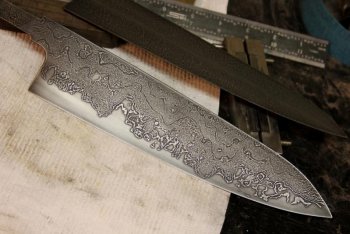Why are you against soaking?
Although "soaking" has become a widly accepted practice within the knife making world over the last decade, which I attribute to the "instant gratification" generation, experience and experimentation over the past 20+ years has taught me that it often does more harm then good. Personally, I think it's because "data" is so much more available, and most folks simply are unwilling to take the time and effort to ensure the "data" they depend on, is actually good.
Now before somebody sends out the "lynch mob" for me, let me explain.....first and foremost is the simple fact that EVERY heat treat book or manual out there always bases the included data on a "one inch cross section" of the given steel type. Can't speak for anyone other then myself, but I have never produced a knife blade that is 1 inch thick. (if you look closely at just about any book or other reference material about heat treating, somewhere you will find (usually in very small print) a statement that says something like... All data based on 1" cross section.
Years ago, after discovering that statement, it made me start questioning the data contained in heat treat manuals/references, and just how much of it was truley relevant to knifemaking......it also lead me into testing and experimenting towards the goal of finding my own answers. After several years, and a file cabinet full of test results, I came to realize that there is a major difference in the knife steels that I use (those I consider "forgeable") between allowing a blade to "soak", and not "soaking", which I believe is due in no small way to the cross section sizes we use in knifemaking, versus the 1" cross sections used to acqure the majority of available heat treating data.
The differences in some steel types can be minor, but in other steel types such as 52100, soaking at or above the austinizing temp basically causes the grain size to "explode" versus allowing the blade to just reach it's austinizing temp and then quench, which ALWAYS returned test results showing significantly smaller grain size, as well as other favorable aspects.
Each steel type manifests some differnt concerns for me involving "soaking", but generally speaking, as with most things concerning knife blades, it's a matter of "trade-offs", and in my opinion, for my knives, the detrements of "soaking" are not acceptable versus not allowing a blade to "soak".
I've had many discussions, and even some heated ones with folks who want to point out that "all the accepted data" states that soaking is appropriate, and should be done. I'm not out to force change upon anyone, nor to dissuade others from doing what they believe in, I'm simply secure in my position that "soaking" isn't something I choose to do to my blades, and the "data" that I've compiled proves it for me.
In a nutshell it's really all about the performance of the finished knife, and I believe that each individual must determine for themselves what is, and what is not acceptable. Simply stated, I can produce a a blade that performs "better" by not "soaking" then I can from the same steel that is allowed to "soak", in just about every aspect that matters to me and my customers.
Kind of long winded, trying to put 20+ years of experience into a few paragraphs, but that's the reasons I do not "soak" during heat treating.

